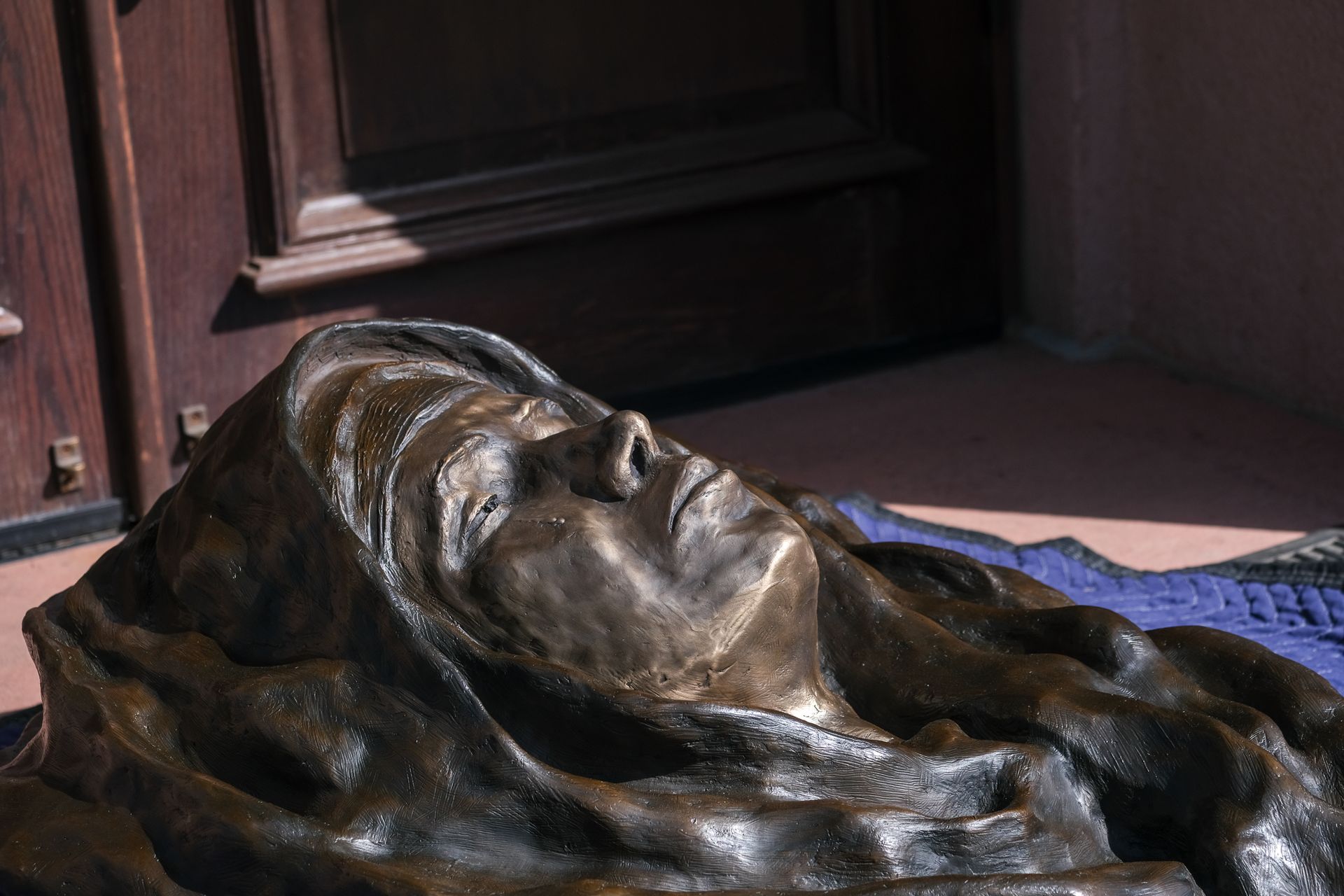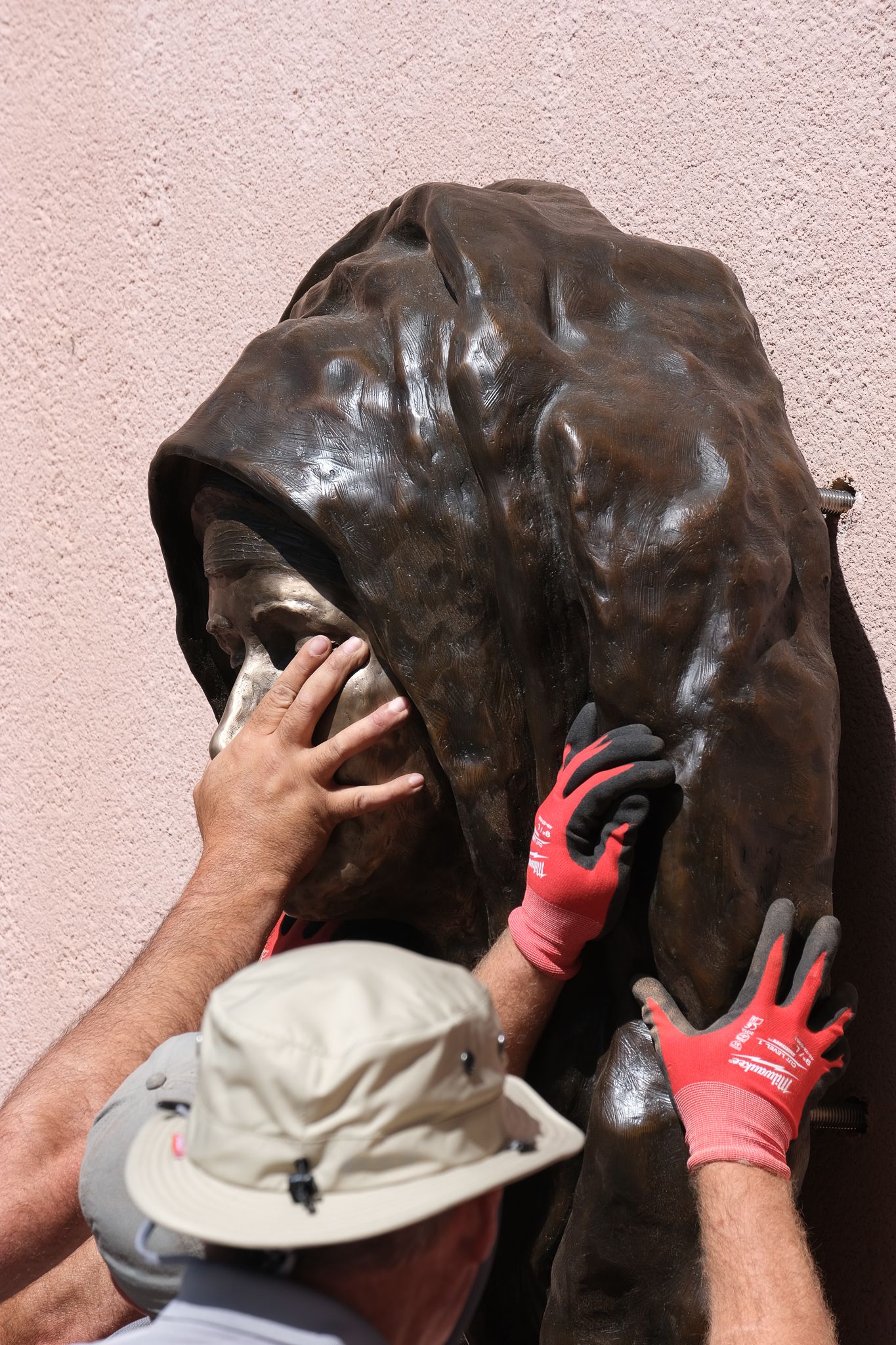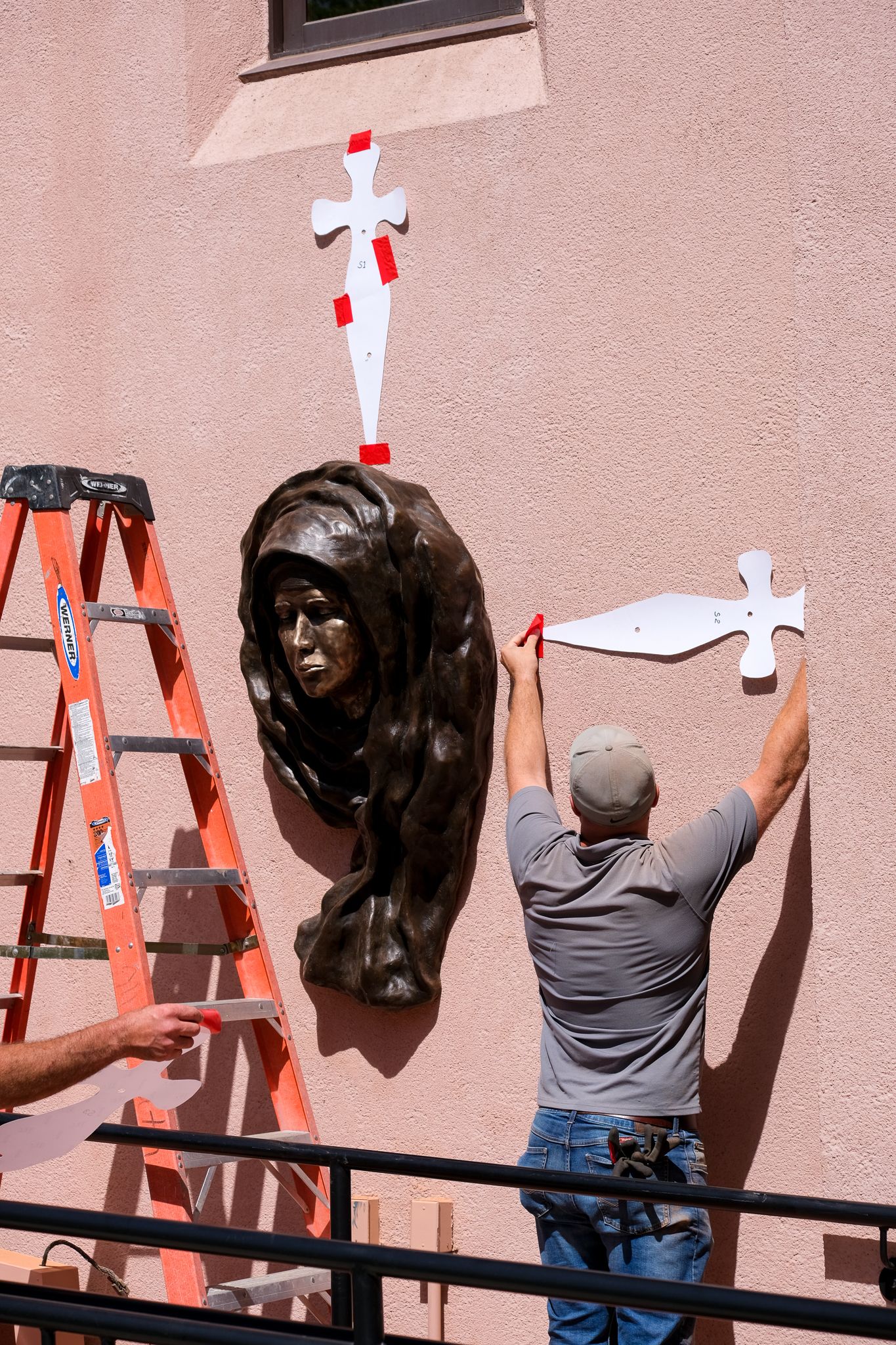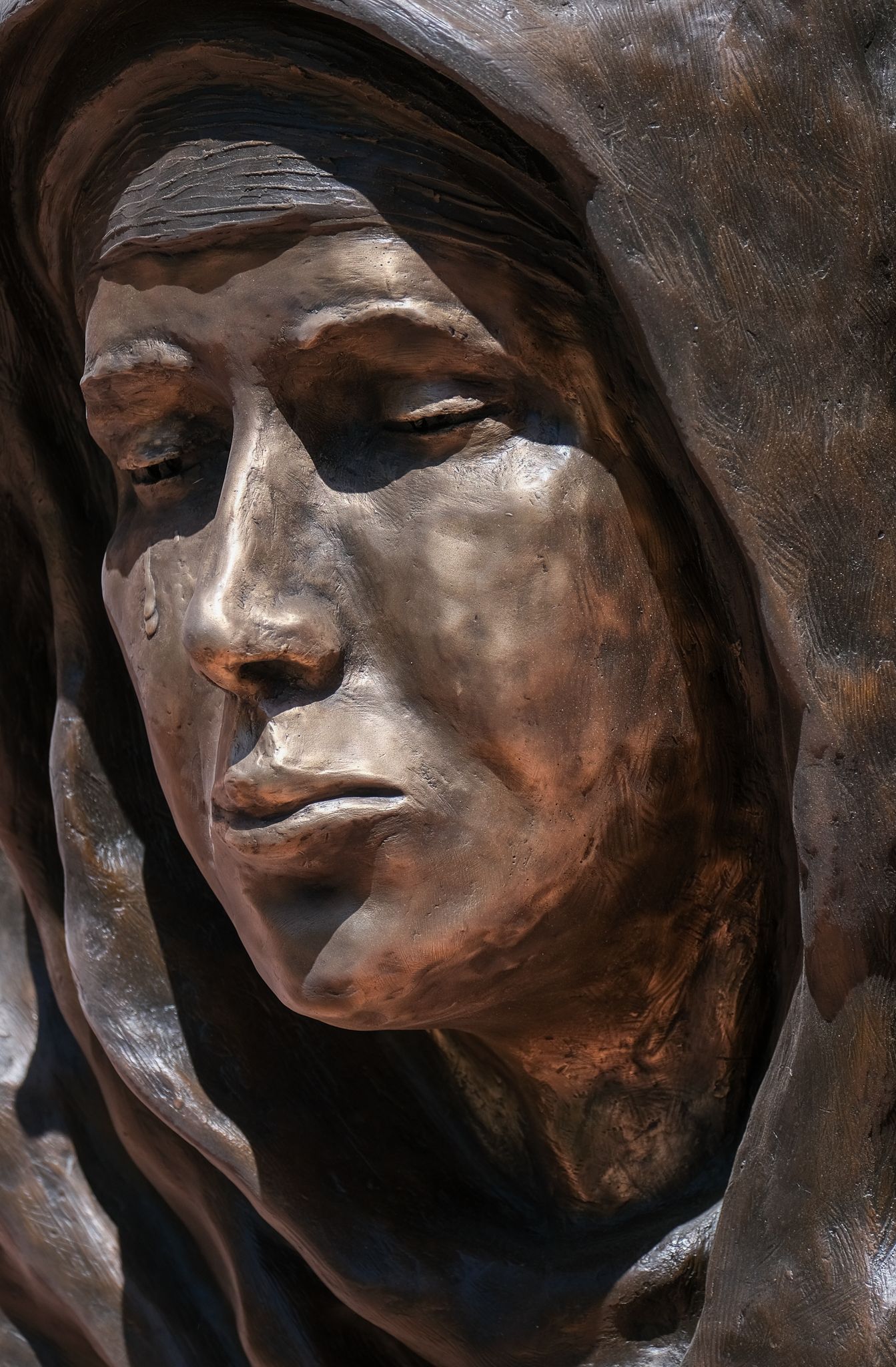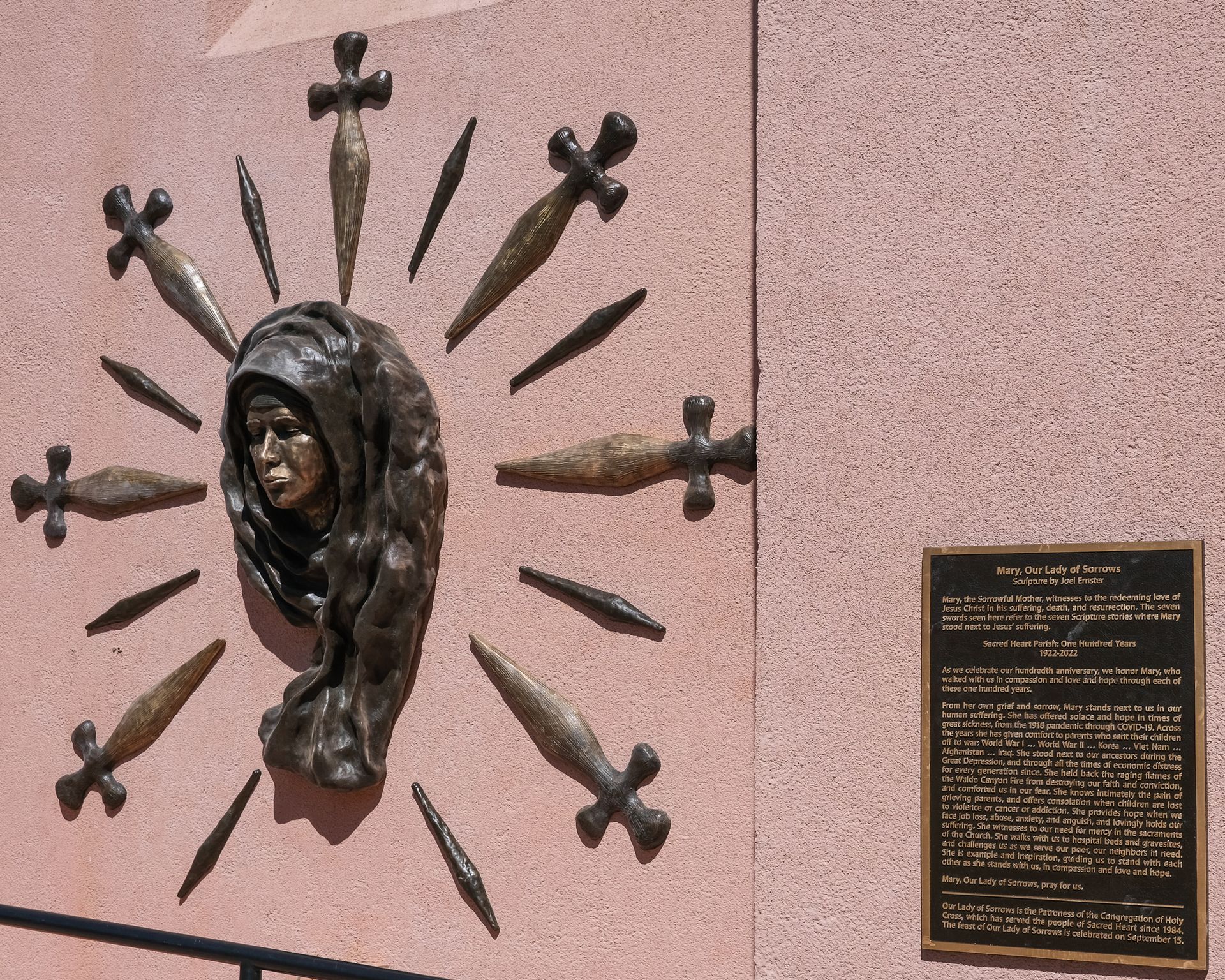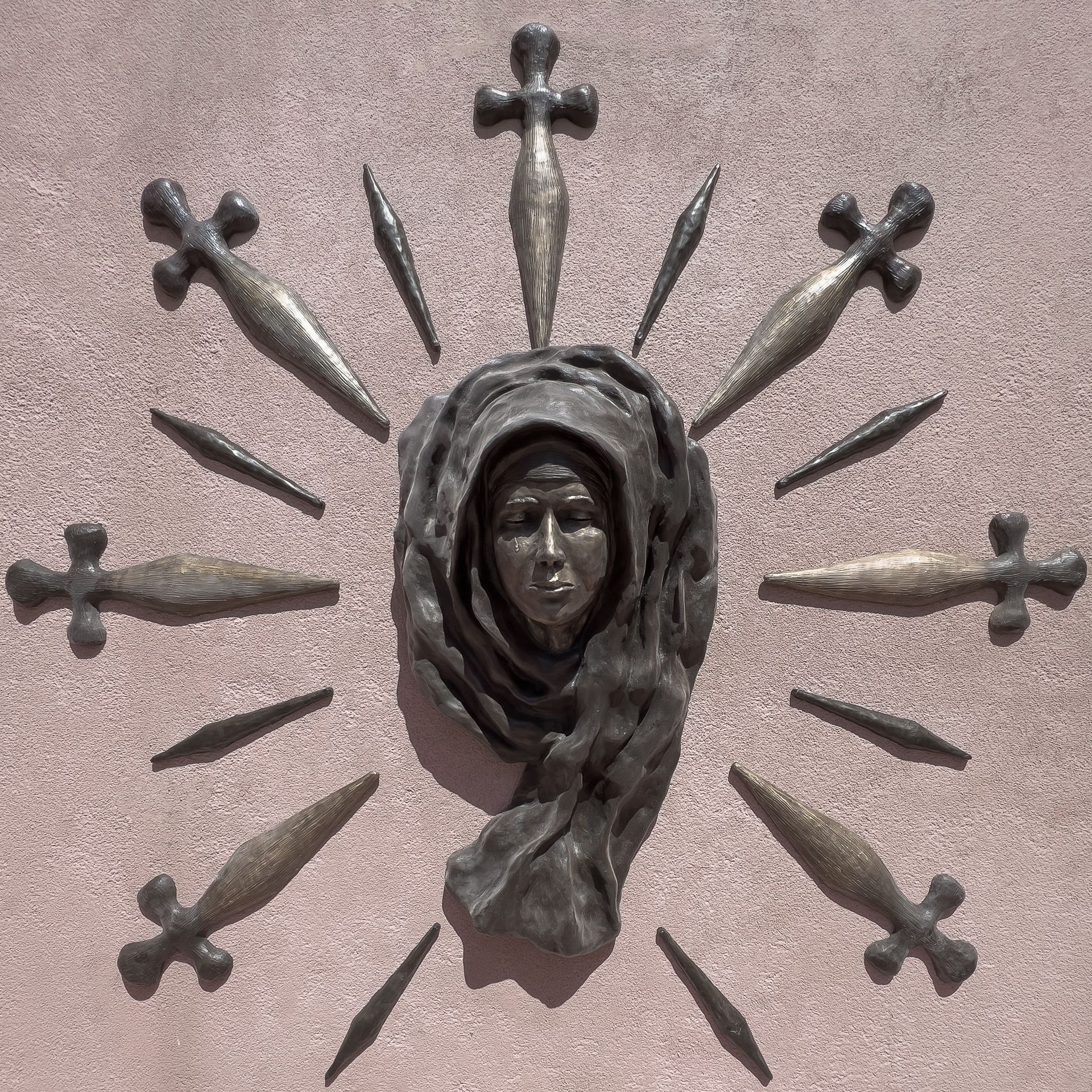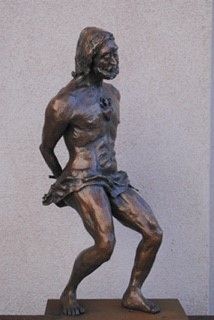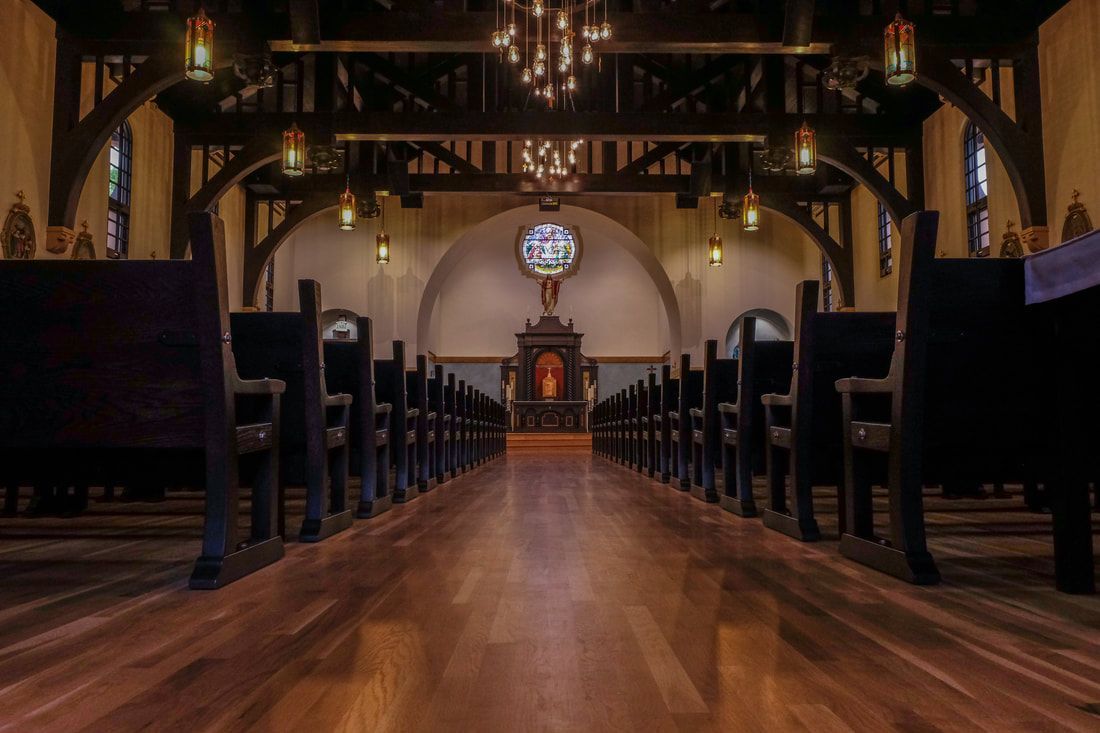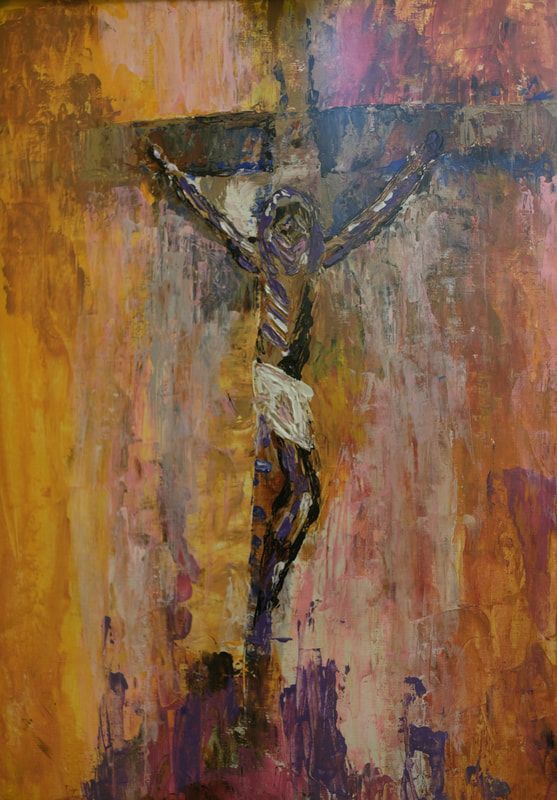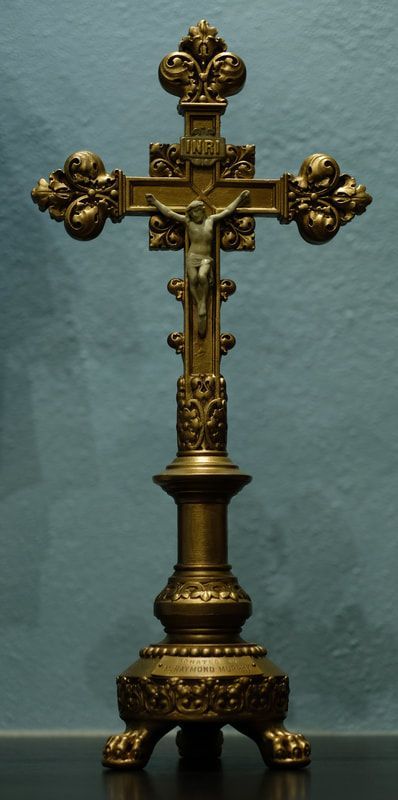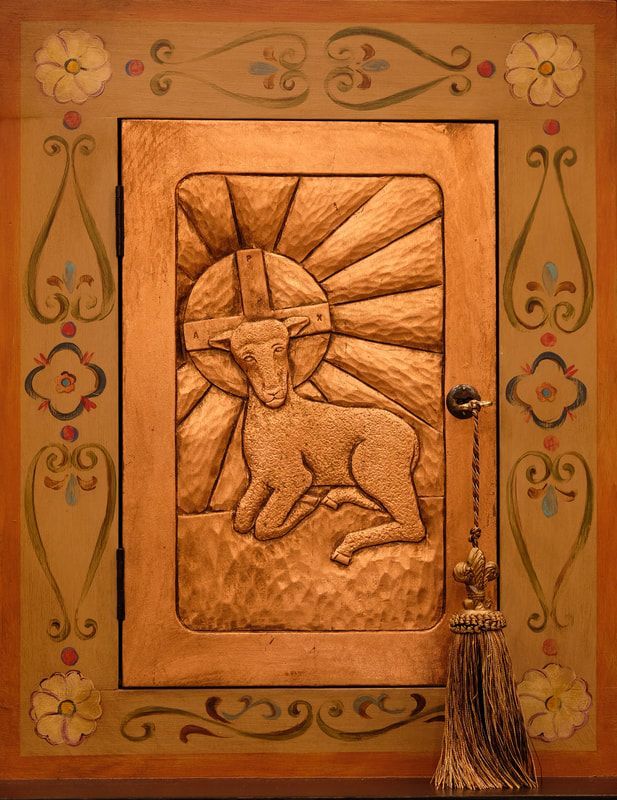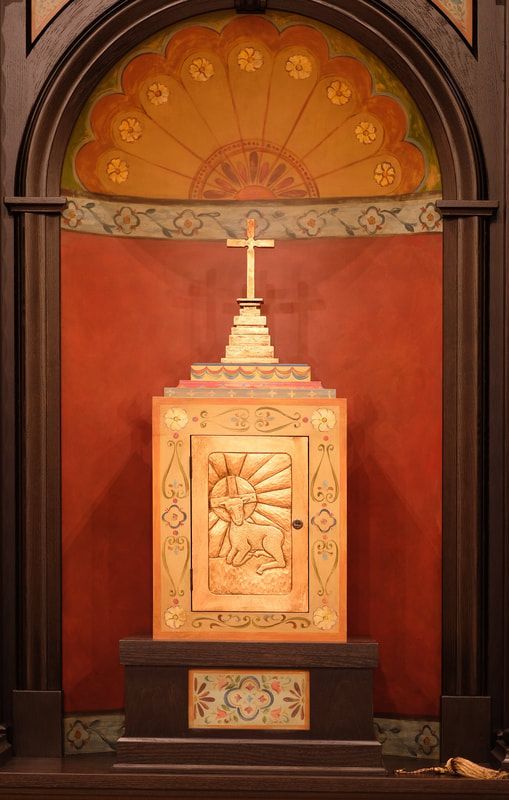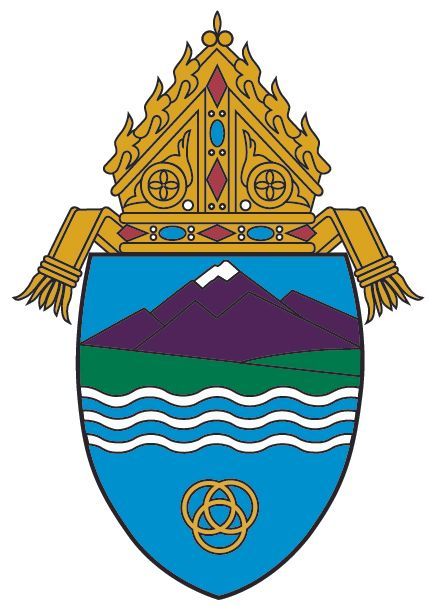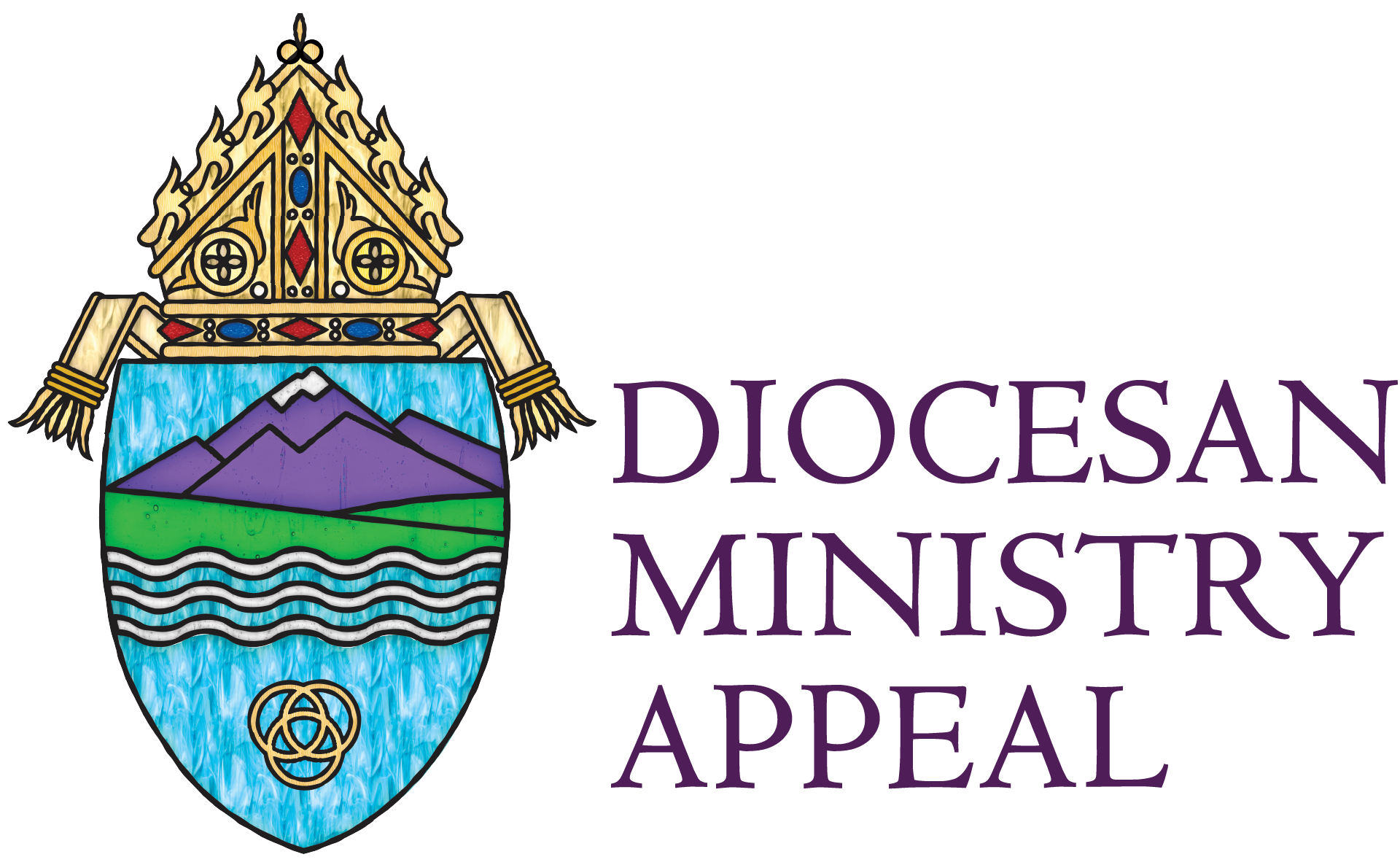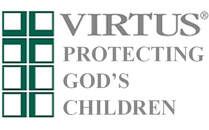Art at Sacred Heart
Art at Sacred Heart Church
Our Lady of Sorrows Sculpture by Dr. Joel Ernster
For the parish's 100th Anniversary in 2022, Sacred Heart Parishioner Dr. Joel Ernster created the Our Lady of Sorrows Sculpture that now hangs on the exterior of the southeast corner of Sacred Heart Church. Dr. Ernster and former pastor Rev. Ronald Raab, C.S.C. (2013-2022) brainstormed the project to honor the Congregation of Holy Cross and the human and spiritual journey of parishioners. The project took over two years to complete. The sculpture along with a commemorative plaque was dedicated on Saturday, July 16, 2022 by Bishop William Wack, C.S.C. of the Diocese of Pensacola-Tallahassee, Florida who was an associate pastor at Sacred Heart Parish from 1994-1997.

Sculpture "Ecce Homo" by Dr. Joel Ernster
In 2020 Sacred Heart Parishioner Dr. Joel Ernster donated his sculpture "Ecce Homo," (Behold the Man), a bronze statue depicting Jesus Christ with the Sacred Heart standing before Pontius Pilate.
Pictured Above Left: "Ecce Homo" by Dr. Joel Ernster.
Pictured Above Right: Dr. Joel Ernster stands next to the sculpture that he donated to Sacred Heart Church.
In February 2021, Dr. Ernster shared with Sacred Heart Church another one of his beautiful sculptures, "Gethsemane," depicting Christ praying in the Garden of Gethsemane on the first Good Friday. This sculpture was on loan during the Lenten season to invite parishioners into deeper prayer and contemplation.
Thank you Dr. Ernster for sharing your beautiful artwork with Sacred Heart Church!
Baptismal Font
Parishioner Geoffrey Keating of Keating Woodworks designed and handcrafted our baptismal font near the sanctuary step at Sacred Heart Church. The eight-sided design represents the Resurrection of Christ Jesus. The eighth day suggests that baptism in the Risen Christ becomes our second birth. Our real identity as Christians rises out of baptism. We are born again in the passion, death and resurrection of Christ Jesus.
Local artist Anna Conklin painted the eight art panels on our new baptismal font. Anna is a professional muralist. She captured the unique images of our faith as they relate to our three churches with beauty and purpose.
Former Sacred Heart Pastor Fr. Ron Raab, CSC (2013-2022) initially met with Anna and they discussed how the images would give meaning and depth to the sacrament of Baptism. Fr. Ron desired that all eight of the images should rise out of the waters of baptism. Anna just happened to have a tapestry in her home with flowing water at its base. She used that image of flowing water in the bottom of each painting to capture the notion that all aspects of faith rise out of our baptism. Baptism forms the mission of the Church. Baptism is both our unity and our challenge to work for justice and peace in our world.
1. The Lamb of Resurrection:
This image is at the core of our faith. It depicts Christ’s rising from the dead, the Easter event. We belong to God in baptism. We are children of the Resurrection and our lives are meant to give faith, hope and love to our Church and world. The Lamb of God, who takes away the sins of the world, also calls us back to our common table of Eucharist.
2. Cross and Anchor:
The Congregation of Holy Cross has served the three church communities of Sacred Heart Parish since 1984. The logo of Holy Cross is the cross and anchor. The Cross, our only hope, is the sign of redemption. The Anchor is our stability, our hope in Christ Jesus. The anchor rises from the waters of our baptism.
3. Saint André door:
The image of the door represents the life and ministry of Saint André Bessette, the first canonized saint in the Congregation of Holy Cross. Brother André was a porter for over forty years, welcoming people and healing them in Montreal, Canada. He died in 1937 and was canonized on Sunday, October 17, 2010. This door actually functions as a door for refilling the water in the font.
4. Jerusalem Cross:
The image of the Jerusalem Cross and the date, “2018” represents the year of the restoration of Sacred Heart Church. The cross is also a “signature” of Fr. Ron Raab, C.S.C. who was the pastor of Sacred Heart Parish during the restoration of the church. The Jerusalem Cross was also on his chalice, paten and ring.
5. The Rosary:
The image of the rosary represents our Holy Rosary Chapel community in Cascade, Colorado, a mission of Sacred Heart Parish. Holy Rosary Chapel was built in 1930.
6. Bowl and Pitcher:
The bowl and pitcher represents foot washing from the Holy Thursday liturgy. This is our call to serve people from our baptismal life. In our community, we serve people in so many ways that gives meaning to this liturgical action in memory of Jesus washing feet at the Last Supper. Our work to feed the hungry, comfort the afflicted, and welcome the stranger, comes from Jesus’ model on the night before he died when he washed feet and shared his presence in the Eucharist.
7. Perpetual Help Heart:
This image represents Mary and Our Lady of Perpetual Help, a mission of Sacred Heart Parish in Manitou Springs, CO. We rely on Mary’s perpetual presence in our world, in our afflictions and in our quest for Jesus.
8. Lily:
The lily is a traditional image of Saint Joseph who was the spiritual inspiration of Saint Andre Bessette. Brother Andre believed that Saint Joseph would heal the Church and all the individuals who come to him in prayer because of his nearness to Jesus Christ.
Below is a gallery of art in the restored Sacred Heart Church
Photos by Sacred Heart Parishioner John Goddard
Santos
“The art of the santero has been central to the sustenance of the Hispanic culture in New Mexico and Southern Colorado for nearly 400 years. From village churches to private chapels to the sacred moradas of the Penitente Brotherhood, the work of individual santaros have provided generations of Hispanics with inspiring symbols of a shared identity of faith, and a collective hope for the future.”
The Santos in Sacred Heart Church was donated by the Hispanic Community in honor of Fr. Leroy Clementich, C.S.C. in 1993. It is in the niche of Sacred Heart Church. Featuring ten saints with Our Lady of Guadalupe in the middle, it tells the story of religion through art. Each saint depicted tells the story of their life and Christian faith.
St. Michael the Archangel/ San Miguel Arcangel
St. Michael the Archangel is the angel of judgement and Divine wrath who clears the way for the second coming of Christ at the end of the world. AS the warrior among the angels, St. Michael fights to save souls from Satan at the moment of death. He is usually depicted with a sword in one hand to conquer the forces of evil, and a vanquished dragon at his feet. He also holds the scales of judgement to weigh the good and evil deeds done in life of human souls at the coming judgement of God.
The restoration of Sacred Heart Church was more than just the renovation of a building. It's a legacy for future generations to come, a church that will stand in service to the community. We were excited to celebrate Sacred Heart Church's 100th Anniversary on July 16, 2022.
St. Gertrude the Great/ Santa Gertrudis La Magna
St. Gertrude was a Benedictine visionary of the 13th century devoted to the study and worship of the Sacred Heart of Jesus, known for her writings of mystical experiences and visions. Her writings were re-published in the 16th century and were particularly popular in Spain where mystics such as St. Teresa adopted St. Gertrude as her model and guide.
Devotion to St. Gertrude traveled from Spain to the New World in the early colonial period. She is depicted as a nun, wearing a full black robe of the Benedictine Order and carrying a staff. In her other hand she is holding the Sacred Heart.
The Holy Trinity/ La Santisima Trinidad
The representation of the Holy Trinity used in retablos in New Mexico is the image of three men with identical features. This comes from a passage in the first chapter of Genesis, where God on the sixth day of the Creation announces His resolution with the words: “Let us make man in our image, after our likeness.” (Genesis 1:26) The interpretation of that passage meant that the creation was the work of the Holy trinity and if man was created after the likeness of the Trinity, the threefold Deity bears that features of man.
The bodies of the three holy persons are shown grown together by the artist to express the idea that the Holy Trinity is threefold and one at the same time.
St. Anthony of Padua/ St. Antonio de Padua
St. Anthony was a 13th century Franciscan friar, noted for his many miracles. He is depicted as a young man, holding the Christ Child, who appeared to him in a vision. St. Anthony is asked to intercede for worldly blessings, such as the findings of lost objects, marriage, fertility and recovery from sickness.
IN the southwest, St. Anthony and other Franciscans are usually depicted in blue robes rather than the brown or gray of European usage. Many groups of the Franciscan friars in colonial New Spain chose to wear blue in honor of the Immaculate Conception of Mary, whose primary color is blue.
St. Raphael the Archangel/ San Rafael Arcangel
St. Raphael is the third archangel to be mentioned by name in the canonical Scriptures. His name in Hebrew means “God has healed.” In the Book of Tobias he was the traveling companion and protector of Tobias as he journeyed to find a miraculous fish which would cure his father’s blindness. Raphael was successful in restoring the sight of Tobias’ father, and as the Physician of God he is accorded a merciful and restorative function, being invoked for eye and other ailments, and for insuring a safe journey. He is depicted in pilgrim’s clothes, holding a pilgrim’s staff and a fish.
St. Teresa of Avila/ Santa Teresa de Avila
St. Teresa, a noblewoman of Avila, founded the Discalced Carmelites for nuns wishing to live a strict enclosed spiritual life. After many years of struggle within the Carmelites, Pope Gregory XIII at the instigation of King Philip II acknowledged the Discalced Reform as a separate province. One of the great mystics of all times Saint Teresa was intelligent, hardheaded, charming, deeply spiritual, and successfully blended a highly active life with a life of deep contemplation. She is the patron saint of pilots, aviation and mystics. St. Teresa of Avila is depicted in nun’s garb, holding a crucifix and a palm.
St. Joseph/ San Jose
St. Joseph is universally esteemed as the patron saint of the family. He is the husband of Mary and the earthly father of Jesus. St. Joseph is the idea saint, man, husband, and was popularly invoked for a number of circumstances. He was a carpenter and a builder. St. Joseph is also the protector of workingmen and the patron of social justice. He is usually depicted in a flowering robe, wearing a crown and holding the Christ Child in his arms. In his other hand he holds a flowering staff. This latter attribute refers to the miraculous blossoming of his staff during the courtship of Mary, which led to his being selected by the holy men as a successful suitor. The flowering staff is also a symbol of the coming Christ.
Our Lady of Guadalupe/ Nuestra Senora de Guadalupe
Our Lady of Guadalupe is the foremost of several images of the Blessed Virgin in the southwest because she has been designated as the Patroness of All the Americas. She appeared to the Mexican Indian peasant Juan Diego in 1531 and her image was miraculously imprinted upon his cloak, a latter day example of an image “made without hands.” This image on fabric has been enshrined ever since in the Guadalupe sanctuary near Mexico City. She is also the patroness against all evil, war and ills. Our Lady of Guadalupe is considered the ideal woman, wife and mother. The Virgin stands on a crescent moon which curves upward over the head of an angelic cherub below, whose hands clasp the ends of her gown and robe. On her head is a many pointed crown of gold. The in halo surrounding her represents the golden light that radiates from the inner glory of her mission of mercy to suffering mankind.
St. Barbara/ Santa Barbara
St. Barbara is the great protectress against lightening and fire. She had been given this extraordinary powers on account of an event which followed her martyrdom. It is told that St. Barbara, daughter of a wealthy heathen in Roman times, was kept by her father in a tower. When left one day for a long journey, he had a bath house build for her, which was to have two windows. On his return, he discovered that his daughter had adopted the Christian faith and, as an outward sign of her conversion, had changed the number of windows from two to three in honor of the Holy Trinity. In his anger the father brought her before the prefect, who condemned her to death. He even carried out the capital punishment himself, but Santa Barbara had hardly given up her soul when the unbelieving parent was struck down by lightening as the penalty for his cruelty.
A passage in her legend related that when she had fulfilled her martyrdom, she was granted by God the privilege of intercession on behalf of those who have honored her memory. Her attributes are a tower, lightening and a martyr’s palm. She wears a blue tunic, red cloak and a three-tiered skirt.
St. Francis of Assisi/ San Francisco de Asis
St. Francis of Assisi is the founder of the Order of Friars Minor. St. Francis and the Order he founded represent a renewal of the Christian spirit in the late Middle Ages. The devout ideals of the Franciscans inspired all of Europe from rulers to the poorest peasants. In the 16th century the Franciscans were the first to come to the New World to convert the Indians to Christianity. They later came to New Mexico and ministered to the Indians and colonists for over 200 years. The pious example of St. Francis became the model for Christian life in Europe and the New World. Known for his devout emulation of the suffering of Christ, he is depicted as the ideal penitent, bearing the stigmata and meditating upon the cross and upon a skull- symbol of the impermanence of human life.



